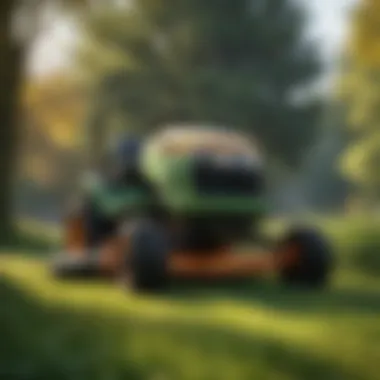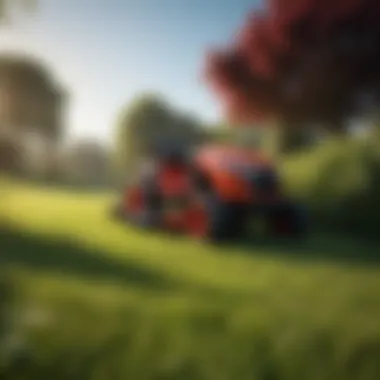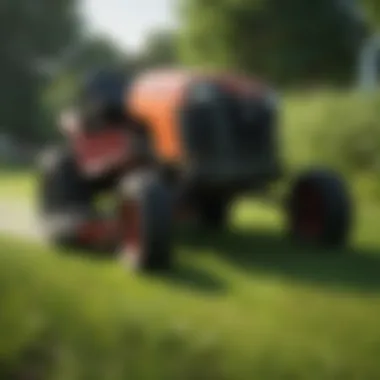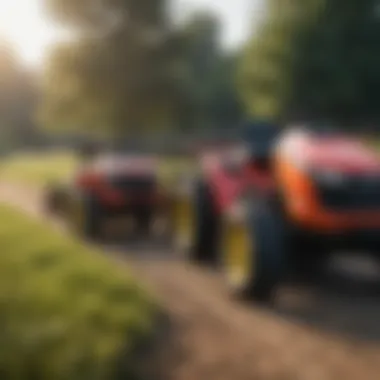Selecting the Right Horsepower for Riding Mowers


Intro
Selecting the right horsepower for a riding mower is a critical decision for those who aim to maintain a healthy lawn. The horsepower required depends on several factors ranging from the size of the area to the type of terrain. A clear understanding of these factors can lead to better performance and efficiency in lawn care. This guide offers a thorough exploration of these factors, ensuring that homeowners and gardening enthusiasts can select the most appropriate riding mower for their unique needs.
Current Trends in Agriculture and Horticulture
The landscape of home gardening and lawn maintenance is shifting. More homeowners seek efficient, sustainable options that not only provide aesthetic value but also protect the environment. This rising trend embraces both technology and sustainable practices, influencing mower choices significantly.
Overview of Recent Innovations
In recent years, manufacturers have introduced advanced mower models that emphasize efficiency and user-friendliness. Developments include electric riding mowers that eliminate exhaust emissions and reduce noise, appealing to environmentally-conscious consumers. Furthermore, innovations in mower design allow for better maneuverability in tight spaces, expanding options for consumers.
Sustainable Practices Gaining Popularity
Sustainability has become an integral consideration in modern lawn care. Homeowners are now interested in mowers that minimize chemical use, promote soil health, and yield better grass growth. Riding mowers equipped with mulching capabilities refine clippings back into the lawn, enriching the soil naturally.
Key Considerations for Horsepower Selection
Understanding power requirements is essential. Different tasks demand different horsepower levels. Factors such as the size of your lawn, the complexity of the landscape, and the mower's function all play significant roles. For example, a flat lawn requires less horsepower than a hilly or uneven terrain.
"Choosing the right horsepower can maximize your mowing efficiency while reducing strain on the machine and the operator."
The End
Understanding Horsepower in Riding Mowers
Definition of Horsepower
Horsepower is a unit of measurement that quantifies the power output of an engine. Originally, it was defined to compare the output of steam engines with that of draft horses. In the context of riding mowers, horsepower refers to the engine's ability to perform work. Generally, higher horsepower ratings imply more power and greater ability to tackle challenging terrains.
Horsepower can be calculated differently depending on various factors such as engine type and design. However, for consumers, it is essential to understand this rating simply as a measure of power that affects overall mower performance.
Importance of Horsepower in Performance
Horsepower plays a significant role in the performance of riding mowers. A mower with insufficient horsepower may struggle with tough grasses, hilly landscapes, or dense weeds. This can lead to uneven cuts and increased wear on the mower. Conversely, excessive horsepower is not always beneficial either, as it can lead to wasted fuel and unnecessary strain on the equipment.
"Choosing the right horsepower is crucial for maximizing both efficiency and performance."
When evaluating how much horsepower is necessary, consider the following:
- Type of Lawn: A flat, well-maintained lawn demands less horsepower than a rough, uneven terrain.
- Mowing Frequency: Regular mowing leads to thicker grass, increasing the load on the mower.
- Desired Speed: Higher horsepower allows for faster mowing speeds without sacrificing cut quality.
- Additional Attachments: If you intend to use the mower for additional tasks, such as pulling a trailer or using a bagger, more horsepower may be necessary.
Understanding these factors will aid in selecting the right horsepower rating to match both your needs and the conditions of your lawn. The decision will ultimately influence your mower's efficiency, durability, and cutting performance.
Assessing Your Lawn Size
Measuring Your Lawn Area
To get an accurate assessment of your lawn size, you can start by measuring its dimensions. The most straightforward method involves some basic tools: a measuring tape or a measuring wheel. Begin at one end of the lawn, and measure the length and width. For rectangular or square-shaped lawns, simply multiply the length by the width to get the area in square feet. For irregular shapes, break the lawn into smaller sections, measure those, and add them together.
If you’re unsure about manual measuring, you might consider using smartphone apps that offer land measurement capabilities. These tools can simplify the process and provide more precision, especially for complex geometries in your lawn.
"Proper measurement of lawn size is fundamental to making an informed choice about the horsepower needed for your riding mower."
Impact of Lawn Size on Mower Choice
The size of your lawn plays a significant role in determining the horsepower that your riding mower should have. For small lawns of less than one acre, a mower with lower horsepower, typically ranging from 13 to 16 horsepower, may suffice. These models can effectively handle the lighter load of smaller areas, sparing you from spending extra on unnecessary power.


On the other hand, for lawns that exceed two acres or have thick grass, opting for a mower with 20 horsepower or more is wise. These mowers possess the strength to cope with heavy-duty tasks and ensure you can complete mowing in less time. A more powerful mower can maintain speed and efficiency, making your mowing experience quicker and more satisfying.
When assessing these factors, consider the terrain type as well. For flat terrains, you might not need as much horsepower. However, in hilly or uneven landscapes, higher horsepower becomes essential for maintaining mower stability and performance. Each of these factors should guide you towards selecting a riding mower that is well suited to your specific lawn size requirements.
Key Features of Riding Mowers
Understanding the key features of riding mowers is essential when selecting the appropriate horsepower. These features not only define the mower's performance but also offer insights into how well it can meet your specific lawn care needs. An effective riding mower combines horsepower with various features, ensuring that every inch of your lawn is maintained efficiently. Evaluating these elements can enhance mowing efficiency and user comfort.
Cutting Width Considerations
Cutting width is a significant factor. It determines how much grass can be cut in a single pass. Wider cutting decks allow you to cover more ground, potentially reducing mowing time. A mower with a cutting width of 42 inches, for instance, is suitable for medium to large yards. However, if your lawn has tight spots or intricate landscaping, a narrower cut around 30 inches can be more manageable.
Key Points about Cutting Width:
- Efficiency: Wider decks mean fewer passes.
- Maneuverability: Narrower decks handle obstacles better.
- Lawn Type: Consider the layout and terrain when deciding on the width.
Deck Material and Its Importance
The material of the mower deck plays a crucial role in its durability and weight. Steel decks are common and offer strength, allowing them to withstand hard use. However, they can be heavy, which might affect maneuverability. Lighter materials such as polyethylene are resistant to corrosion but may not have the same longevity. The choice of material can influence not just the mower's lifespan, but also its ease of use.
Considerations for Deck Material:
- Durability: Steel generally lasts longer.
- Weight: A lighter deck aids in maneuverability.
- Maintenance: Some materials require more care than others.
Transmission Types and Performance
The transmission of a riding mower affects how power is delivered to the wheels. There are generally three types of transmissions: manual, automatic, and hydrostatic. Each has distinct characteristics that can shape performance.
- Manual Transmissions: Often more basic but allow for full control over speed.
- Automatic Transmissions: Easiest to operate. These adjust the speed automatically, making them suitable for beginners.
- Hydrostatic Transmissions: Provide smooth operation and precise control. They can be more expensive but enhance performance significantly.
The right transmission type should align with your mowing habits and the specific characteristics of your lawn.
"Selecting the proper features of a riding mower ensures optimal functionality and satisfaction in lawn care."
Terrain Types and Their Implications
Flat vs. Hilly Terrain
Flat terrain generally allows for easier mowing. The mower can maintain speed and operate efficiently without struggling against inclines. Typically, a mower with lower horsepower can satisfy the needs for maintaining vast flat lawns. It is important, however, to ensure that the mower has a wide enough cutting deck to cover large areas quickly.
In contrast, hilly terrain requires more attention. A mower operating on hills must exert more force to maintain stability and grip. Higher horsepower ratings are often advised in these cases. Mowers with more power can navigate inclines more safely and efficiently. An inadequate horsepower rating could lead to stalling or overheating, which is undesirable during mowing tasks.
Consider the slope of your lawn when deciding. The steeper and more uneven the terrain, the more horsepower you will require to manage it effectively. A small amount of horsepower might suffice for light slopes if the mower is equipped with proper features for grip and traction. For serious slopes, however, a more robust machine is essential.
Dealing with Obstacles on the Lawn
Obstacles create additional considerations. Lawns may contain trees, rocks, or garden beds that need to be navigated during mowing. A mower designed for obstacles should have good maneuverability and sufficient power to avoid stalling when encountering resistance.
If your lawn has a lot of obstacles, choosing a mower with a higher horsepower can be beneficial, as it can provide the extra power needed to handle sudden changes in the terrain. Additionally, features like a tighter turning radius become more useful in these cases, allowing for more efficient navigation around various objects.
Frequency of Mowing
Determining Your Mowing Schedule
Establishing a mowing schedule involves multiple factors such as grass growth rates, seasonal weather changes, and personal availability. Consider how often you want to mow your lawn. Some property owners opt to mow weekly during growing seasons, while others may do it biweekly or as needed. The type of grass and local climate will significantly impact how quickly your lawn grows.
If your lawn is composed of fast-growing grasses, more frequent mowing sessions will be necessary. This regular interval necessitates a riding mower with higher horsepower to maintain performance without straining the engine. On the other hand, if your grass type grows slowly, you might manage with less horsepower.


Impact on Engine Load and Horsepower Needs
The relationship between mowing frequency and horsepower is straightforward. The more frequently you mow, the more the mower’s engine works. A powerful engine will efficiently cut through dense or long grass, reducing wear and tear on the mower. Adequate horsepower prevents overheating and prolongs the lifespan of the unit.
Here are some key points concerning engine load and necessary horsepower:
- Heavy Loads: More frequent mowing leads to heavier engine loads due to thicker or longer grass.
- Horsepower Requirement: More horsepower allows the mower to tackle these heavier loads effectively.
- Fuel Efficiency: A mower with sufficient horsepower will be more fuel-efficient under these conditions compared to a less powerful model, which could consume more fuel if it struggles to perform.
For instance, if mowing every week during peak growing seasons, a rider with at least 20 horsepower is often recommended for optimal performance. Conversely, occasional mowers may not need this level of power and might find sufficient performance with 15 horsepower.
"Understanding your mowing schedule helps ensure you select a riding mower that will meet your needs without the risk of underperformance."
Personal Preferences and Comfort
When selecting a riding mower, personal preferences and comfort play a vital role. Individual comfort affects efficiency and overall satisfaction while mowing. It's essential to tailor the choice of the mower to fit the user's specific needs.
Operator Comfort Considerations
Comfort for the operator is critical, especially during long hours of use. Factors such as seat design, accessibility of controls, and vibration dampening should be taken into account. A well-cushioned seat can help minimize fatigue, promoting better posture and a relaxed experience. Controls should be easy to reach and operate, allowing users to focus solely on mowing without straining.
Additionally, noise levels in the cabin may affect comfort. Riding mowers with lower decibel ratings contribute to a more pleasant experience, especially during extended use. Thus, considering the operator's comfort is not merely a matter of preference but a necessity for effective lawn maintenance.
Ergonomic Features to Consider
Ergonomic features are increasingly important in modern riding mowers. Some models incorporate adjustable seats and steering columns, enabling users to customize their setup according to their body type. This personalization can greatly improve comfort and reduce the risk of injury.
Foot pedals that are easy to manage, and lever controls positioned strategically can also enhance usability. Features like cup holders and storage compartments add convenience, allowing the operator to focus on the mowing task.
Investing in a riding mower that emphasizes ergonomics could lead to greater productivity and reduced discomfort. Thus, users are encouraged to test various models to find the perfect fit for their preferences and mowing habits.
Cost and Budget Considerations
Cost and budget considerations are crucial when selecting a riding mower. The right investment ensures not only optimal mowing efficiency but also sustainable ownership costs. Understanding your financial limits will shape the options available to you. This section will explore how to evaluate your budget and comprehend price differences among various horsepower ratings.
Evaluating Your Budget
The first step in evaluating your budget is to determine how much you can spend. This involves taking an honest look at your finances. Include the maximum amount you can allocate for the mower itself and the costs of maintenance, fuel, and potential repairs. Let's break this down a bit further:
- Initial Costs: Establish the cost range for riding mowers that meet your horsepower needs.
- Maintenance Costs: Regular upkeep is essential. Items like oil changes, blade sharpening, and potential part replacements should be factored in.
- Fuel Consumption: Depending on the horsepower, fuel consumption may vary significantly. A more powerful mower may consume more fuel, impacting long-term operating expenses.
- Insurance Costs: If you live in an area where insuring the equipment is beneficial, incorporate those potential costs in your calculations.
Setting a realistic budget allows you to identify options that suit your financial situation. Keep in mind that choosing the lowest price model might not always be the best in terms of longevity and performance. This balance is crucial for sustainable ownership.
Price Differences Among Horsepower Ratings
When selecting horsepower for a riding mower, understanding price differences is vital. Generally, as horsepower increases, so does the price. Here are some factors that influence these differences:
- Power and Capability: Higher horsepower typically means improved cutting performance and the ability to tackle tougher terrain.
- Brand Influence: Established brands like John Deere or Husqvarna might charge more due to their reputation and proven performance. Cheaper brands might provide lower initial costs but at the risk of durability.
- Features and Technology: Additional features such as advanced transmission systems or ergonomic designs can also raise the price. Consider if these features are necessary for your needs.
- Market Trends: Seasonal fluctuations can affect prices. It's often wise to keep an eye on promotions or sales, which can reduce costs significantly.
"Choosing a riding mower is not just about purchase price. Long-term cost considerations like maintenance and fuel efficiency are equally important."
Ultimately, understanding the unique price dynamics related to horsepower will help you navigate your options more effectively. Aim to balance between what you need and what you can afford, ensuring that your investment aligns with your lawn care goals.
Maintenance Requirements and Frequency
Maintenance of a riding mower is critical to its longevity and performance. Understanding the maintenance requirements and how frequently these tasks need to be performed can significantly impact the overall functionality of the mower. Regular maintenance ensures that the engine runs smoothly and keeps the mower cutting efficiently. Neglecting these requires can lead to diminished performance or even permanent damage. Thus, an informed choice in mower selection should factor in not only horsepower but also the ease of maintenance.
Understanding Maintenance Demands


Every riding mower comes with its own set of maintenance demands. Common tasks include oil changes, air filter replacements, and blade sharpening. For example, oil changes are usually required after every 50 to 100 hours of mowing, depending on the engine type. The oil ensures that moving parts operate smoothly, preventing wear and tear.
Filters, such as air and fuel filters, also require attention. A clogged air filter can restrict airflow, making the engine work harder and using more fuel. Similarly, sharpening or replacing blades every season ensures a clean cut, which is vital for lawn health.
Identifying the specific maintenance needs of a mower can help you avoid unnecessary downtime. Moreover, some mowers are designed for easier at-home maintenance, while others may need professional services. This distinction should guide your selection process.
Choosing a Mower Based on Maintenance Needs
When selecting a riding mower, it is wise to consider the maintenance requirements in relation to your lifestyle. If you have limited time or mechanical skills, a model with fewer maintenance tasks may be more suitable. Some features to examine include:
- Oil Change System: Some mowers come equipped with easy-access oil drain plugs or systems that simplify oil changes.
- Tool-Free Maintenance: Look for models that allow for tool-free access to critical components, such as belts or blades.
- Service Indicators: Some advanced mowers have indicators that alert users when maintenance is required.
Ultimately, the right mower should fit seamlessly into your maintenance routine. This prevents added stress and ensures that it remains in optimal working condition. The blend of horsepower and maintenance ease creates a balance most beneficial for your unique mowing needs.
Consulting with Professionals
Engaging with professionals can significantly enhance your understanding of selecting the right horsepower for your riding mower. Professionals in this field possess a depth of knowledge that extends beyond basic specifications. Their experience allows them to provide insights into the practical aspects of using different models based on specific conditions and personal preferences. This section outlines the benefits of expert advice and where you can find credible insights.
Benefits of Expert Advice
Consulting with experts offers several distinct advantages:
- Tailored Recommendations: Professionals can analyze your lawn's unique features and help you choose a mower that matches your specific needs. This customization is essential for optimizing performance and efficiency.
- Understanding Technicalities: Horsepower ratings can often be misleading without context. Experts clarify these ratings and explain how they relate to the actual performance of a mower on your terrain.
- Maintenance Insights: Professionals provide valuable information on the maintenance requirements of various models. They can guide you on what to expect regarding servicing needs, which is a critical consideration when deciding on a purchase.
- Long-Term Investment: By consulting experts, you can make a more informed decision that potentially saves you money in the long run. Choosing the right mower can decrease repair costs and increase the longevity of your investment.
- Navigating Market Options: The market for riding mowers is vast and diverse. Professionals can help sift through numerous brands and models to find the suitable options based on your criteria.
Where to Find Professional Insights
Finding credible professional advice involves some research. Here are effective ways to obtain expert insights:
- Local Dealerships: Visit dealerships or authorized retailers where professionals often have the experience and knowledge to guide customers. Engaging in conversation with the staff can yield valuable information.
- Online Forums: Websites like Reddit provide platforms where enthusiasts discuss their experiences. Engaging in these conversations can lead you to seasoned professionals who share their insights.
- Maintenance Services: Contacting a local mower service can connect you with technicians who understand various riding mowers intimately. Their hands-on experience provides a no-nonsense perspective of how different models perform.
- Consumer Guides: Resources like Wikipedia and Britannica often include summaries on riding mower performance and market trends. These can serve as an excellent starting point.
- Social Media Groups: Facebook groups dedicated to gardening and farming communities can be rich with knowledge. Interacting with group members may lead to recommendations for professionals who specialize in riding mowers.
"Choosing the right horsepower for your riding mower is not simply about going for the maximum; it is about finding a balance that suits your specific lawn care needs."
Final Decision-Making Process
In the world of riding mowers, making the right choice encompasses more than just selecting a model based on horsepower. The final decision-making process integrates various elements, from understanding specifications to evaluating personal preferences. This article emphasizes how careful consideration ensures that the investment aligns with both the needs of the lawn and the desires of the operator.
Determining the appropriate horsepower is critical. However, evaluating the mower's overall capabilities is equally important. Riders must reflect on factors such as the lawn size, terrain type, and additional features that may enhance performance. These aspects are intricately linked with the horsepower necessary for efficient operation. The decision should not be isolated to horsepower alone but should incorporate all relevant factors at play.
Benefits of a Holistic Approach:
- Ensures optimal performance for specific lawn needs.
- Prevents over- or under-powered purchases.
- Enhances user satisfaction through tailored choices.
A well-rounded approach will lead to a purchase that minimizes future frustrations and maximizes mowing efficiency.
Weighing All Factors Considered
When approaching the final decision, weighing all factors is crucial. It is easy to get caught up in the horsepower number; however, understanding how it interacts with the other specifications is vital. For example, if one has a large lawn area, higher horsepower may be necessary, but other features will impact the mowing process.
Considerations should include:
- Lawn Size: Greater areas may require more horsepower for efficient mowing.
- Terrain: Hilly or uneven lawns can lead to increased load on the mower’s engine, necessitating additional power.
- Frequency of Mowing: Regular mowing can affect the horsepower needed due to consistent engine load.
- Comfort and Maintenance: Personal preferences for operator comfort and the complexity of upkeep should weigh heavily in the decision.
These aspects intertwine in influencing the ultimate decision. A comprehensive assessment helps in preventing buyer’s remorse or the need for future upgrades.
Making an Informed Purchase
Choosing to purchase a riding mower is a significant decision that requires an informed approach. After methodically weighing all relevant factors, it is essential to finalize the choice based on the findings. An informed purchase hinges not solely on horsepower but also considers the entire functionality of the mower.
To facilitate this informed decision:
- Research Models: Analyze different brands and models that closely match the evaluated criteria.
- Consult User Reviews: Look for insights from current owners regarding their experience with the mower’s performance and maintenance.
- Test Drive Options: If feasible, test the mower to gauge comfort and handling firsthand.
- Evaluate Cost vs. Features: Confirm that the features being offered justify the price point, ensuring value for investment.
Incorporating this structured approach will increase the likelihood of selecting a riding mower that lives up to its promises while fulfilling the operator’s needs. This ultimately results in a reliable lawn care solution tailored to the specific requirements.



